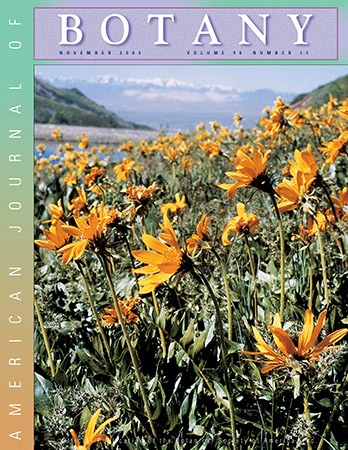
Biology Under Cover
Selected Journal & Book Covers from SBS Faculty
"An ITS phylogeny of Balsamorhiza and Wyethia (Asteraceae: Heliantheae)"
Lynn Bohs
Summary
The golden heads of Balsamorhiza and Wyethia covering the foothills herald spring in Utah’s Wasatch Mountains. Balsamorhiza macrophylla, the cutleaf balsamroot (shown here), commonly grows interspersed with B. sagittata (arrowleaf balsamroot) and W. amplexicaulis (mule’s ear) on hillsides and open woods. Balsamorhiza and Wyethia are closely related, and are the subjects of a phylogenetic study by Moore and Bohs published in this volume of the American Journal of Botany. First author Abigail Moore received her B.S. in Biology from the University of Utah in 2004. As an undergraduate researcher in the Bohs lab, she investigated the evolutionary relationships of Balsamorhiza and Wyethia using molecular phylogenetics. This research was published in the American Journal of Botany (2003) and in Systematic Botany (2007). She is currently an Assistant Professor and Curator of the Herbarium at the University of Oklahoma. Photo by Lynn Bohs taken in Red Butte Canyon, Salt Lake City, UT.
The relationships amog the species of Balsamorhiza and Wyethia (Asteraceae: Heliantheae) were examined using data from the internal transcribed spacer (ITS) region of the nuclear ribosomal DNA. The ITS sequences were obtained from nine species of Balsamorhiza and 14 species of Wyethia as well as seven outgroup genera. Five of the outgroup genera were members of the subtribe Engelmanniinae of the tribe Heliantheae, the subtribe that includes Balsamorhiza and Wyethia. The resulting trees show that Balsamorhiza and Wyethia together form a monophyletic group. Balsamorhiza alone is monophyletic, but neither of its two sections is monophyletic. Wyethia is paraphyletic. One group of Wyethia species, including all members of sections Alarconia and Wyethia as well as W. bolanderi from section Agnorhiza, is monophyletic and sister to Balsamorhiza. The other species of Wyethia (all placed in section Agnorhiza) are part of a polytomy along with the clade composed of Balsamorhiza plus the rest of Wyethia.
